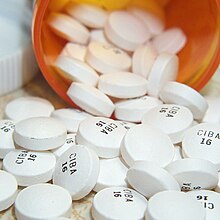Drug coupon
This article has multiple issues. Please help improve it or discuss these issues on the talk page. (Learn how and when to remove these template messages)
|
| Pharmaceutical drug coupons |
|---|
 |
|
Prescription drugs Over-the-counter drugs |
A drug coupon is a coupon intended to help consumers save money on pharmaceutical drugs. They are offered by drug companies or distributed to consumers via doctors and pharmacists, and most can be obtained online. There are drug coupons for drugs from many categories such as cholesterol, acne, migraine, allergies, etc.
Drug coupons as pharmaceutical marketing
Direct-to-consumer or "DTC" marketing of prescription drugs is common in the United States. Patients frequently inquire about or request medications they have seen advertised in print or on television.
Pharmaceutical companies use drug coupons as a marketing tool to stimulate demand for their products.
Drug coupons are commonly offered for new products to stimulate demand or ameliorate high co-pays for non-formulary (non-preferred products) as a way to level the playing field and remove the disincentive for using a drug that is not covered by insurance.
Restrictions
In an effort to avoid unregulated resale of drugs, the Prescription Drug Marketing Act of 1988 banned the traffic or counterfeiting of redeemable drug coupons.[1]
Types
Most drug coupons are printed by consumers using their personal computers and printers. Drug coupons reduce out-of-pocket costs for consumers in a variety of ways such as instant savings offers, free trial offers (also known as try-before-you-buy offers), copay reduction or rebates.
Generic drug companies rarely offer coupons, though insurance companies occasionally offer discounts on generic drugs.[2]
In addition PBMs (Pharmacy Benefit Managers) offer discount cards that act similarly to coupons. These cards work for both generic and brand medications and can save cash paying customers up to 75% on their prescription medication.
Drug coupons and healthcare costs
Critics of prescription drug coupon programs have argued that these programs lead to higher healthcare costs for consumers. Typically, American patients with health insurance pay a percentage of the cost of a prescription drug out of pocket, with insurance companies responsible for the rest of the medication's cost. Insurance companies charge higher copayments for brand-name drugs than for generics in order to encourage patients to choose less expensive alternative medications when they are available. However, by reducing a patient's copayment, prescription drug coupons also reduce a patient's incentive to choose a less expensive generic medication. As an example, NPR reported in 2009 that the generic acne medication Minocin cost $109 a month while a newer alternative called Solodyn cost $514 a month. Solodyn can be taken only once daily, while Minocin must be taken twice daily. Since Solodyn's manufacturer offers a coupon to reduce copays, patients may believe that both drugs cost the same amount.[3]
Drug coupon advocates argue that coupon programs enhance medication adherence by reducing or eliminating drug copays.[2]
As of 2008, the U.S. Food and Drug Administration (FDA) was planning a study to see if coupons make patients overlook drug risks and side effects in their effort to save money.[2] All medicines come with a certain level of risk. This is why all prescription drugs include information reviewed and approved by the U.S. Food and Drug Administration (FDA) about how the medication works in the body, its uses and when it should not be used, possible side effects, the recommended dosage, and other facts about the appropriate use of the drug. Most Americans have never heard of “Risk Evaluation and Mitigation Strategies” (REMS); yet, these drug safety protections give millions of Americans with serious diseases, such as cancer and multiple sclerosis, access to medicines that would otherwise be too dangerous to be allowed on the market.[4] REMS programs exist because certain medicines can cause serious side effects, life-threatening infections, allergic reactions, liver damage or birth defects. Before patients take one of these drugs, they and their prescriber should be aware of the risks, and may need to take certain steps that lessen these risks, in order to ensure they benefit from the treatment.
Unions have filed several lawsuits seeking to ban drug coupons, characterizing them as illegal kickbacks. As of June, 2013 Three of these lawsuits have been dismissed. Six more are pending. This ruling is seen as vindication for the Pharmaceutical industry that drug coupons are an acceptable business practice.[5]
See also
References
- ^ "Milestones in Food and Drug Law History". Food and Drug Administration (FDA). April 30, 2009. Retrieved June 25, 2009.
- ^ a b c Kritz, Francesca (December 3, 2007). "Check out drug coupons, then check bottom line". Los Angeles Times. Retrieved June 28, 2009.
- ^ Joffe-Walt, Chana (October 20, 2009). "Drug Coupons Hide True Costs From Consumers". NPR. Retrieved November 19, 2011.
- ^ "Patients Alliance for Drug Safety Protections". rx24drugs.com. Retrieved June 28, 2019.
- ^ "Bristol-Myers Coupons For Abilify Are Not Bribes: Judge" (PDF). Pharmalive. October 1, 2014. Archived from the original (PDF) on October 6, 2014. Retrieved June 6, 2013.
External links
- "Drug Coupons". AARP. April 15, 2008.
- "Companies, groups help with drug costs". Los Angeles Times. June 8, 2009.
- If Drug Copays Have You Down, Check For A Coupon. NPR. January 7, 2011.
- "Coupons for Patients, but Higher Bills for Insurers" The New York Times. January 1, 2011.
- Articles needing additional references from May 2012
- All articles needing additional references
- Articles with limited geographic scope from December 2014
- United States-centric
- Articles with multiple maintenance issues
- Use mdy dates from May 2012
- Drugs
- Food and Drug Administration
- Drug marketing and sales
- Sales promotion